The coronation of Franz Joseph as King of Hungary in 1867 reinforced the need for expansion and improvement to make the Royal Palace on Castle Hill into a true royal residence. Leadership of this project was assigned, after the death of Miklós Ybl, to another renowned architect of the day, Alajos Hauszmann. His work resulted in a palace complex that ranked among the most distinguished royal buildings of Europe in the early 20th century. In addition to completely renewing the exterior architecture, Hauszmann designed interiors that befitted a royal residence.
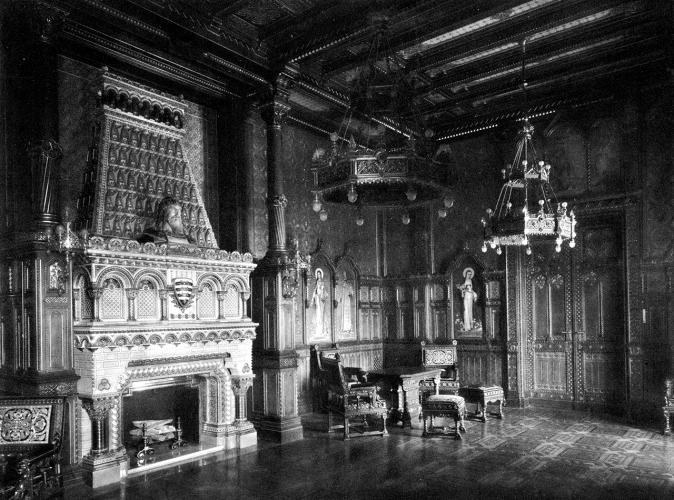
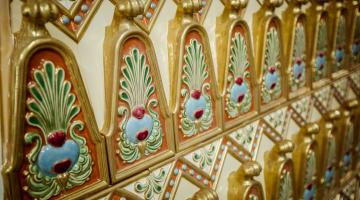
St Stephen’s Hall was placed in the new south range of the palace, and was a true jewel box. It interior had a Romanesque design, but at certain points accommodated some Hungarian ornament and Hungarian character. Hauszmann gathered the finest craftsmen in the country to produce a masterpiece of turn-of-the-century Hungarian applied art. Among those who worked on the furniture, fittings and decoration were Endre Thék, Alajos Strobl and Gyula Jungfer, and the central element of the room, the monumental pyrogranite fireplace, was made in the factory of Vilmos Zsolnay.
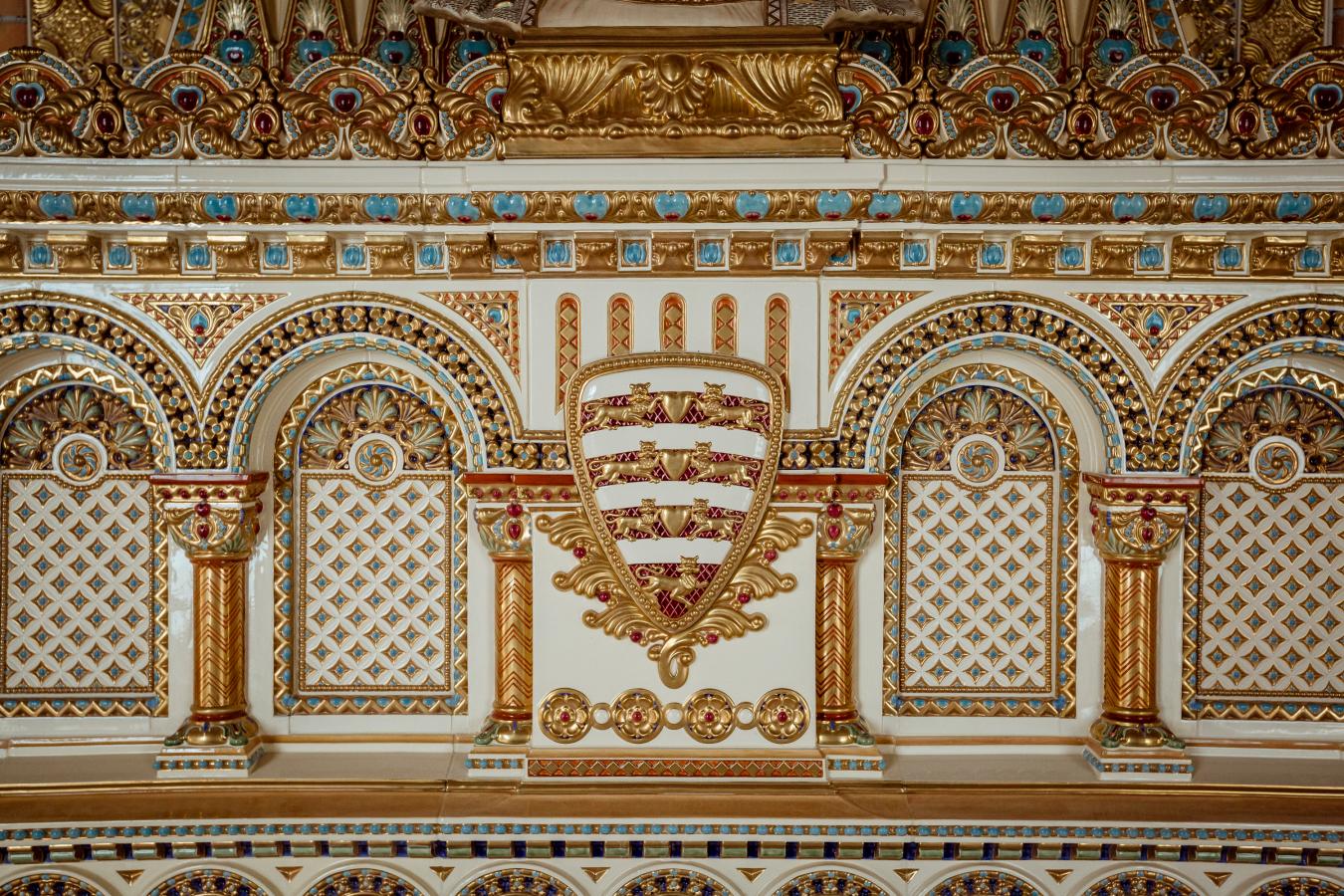
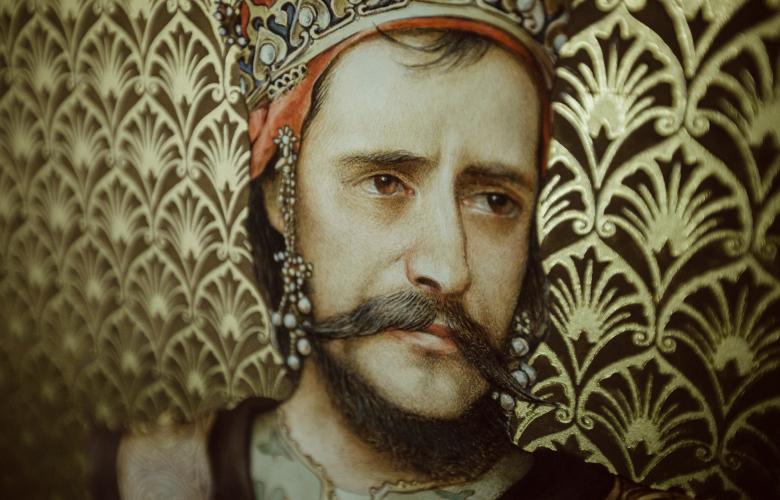
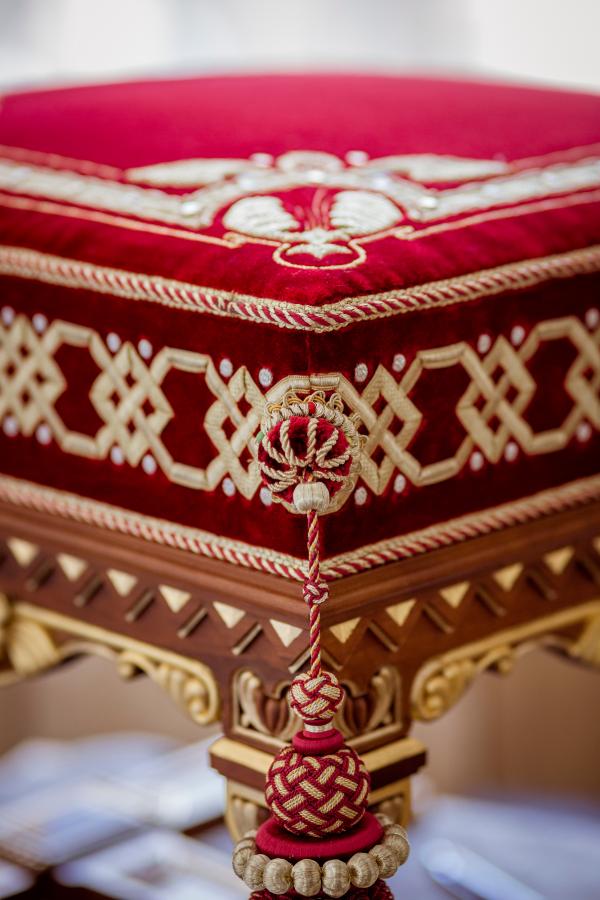
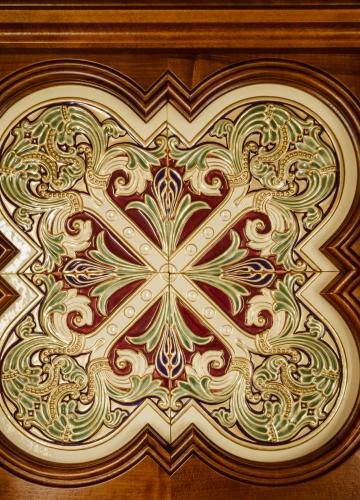
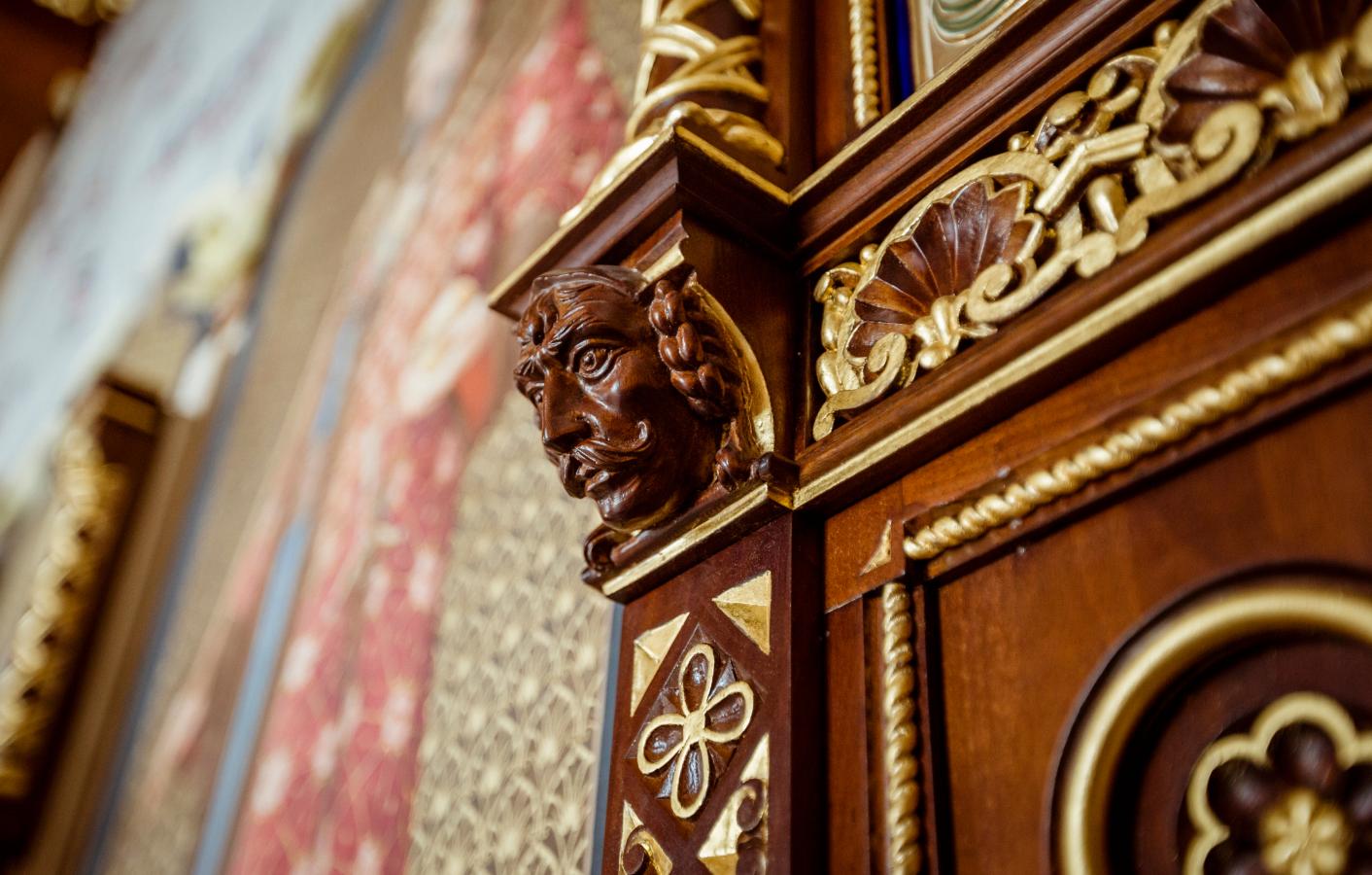
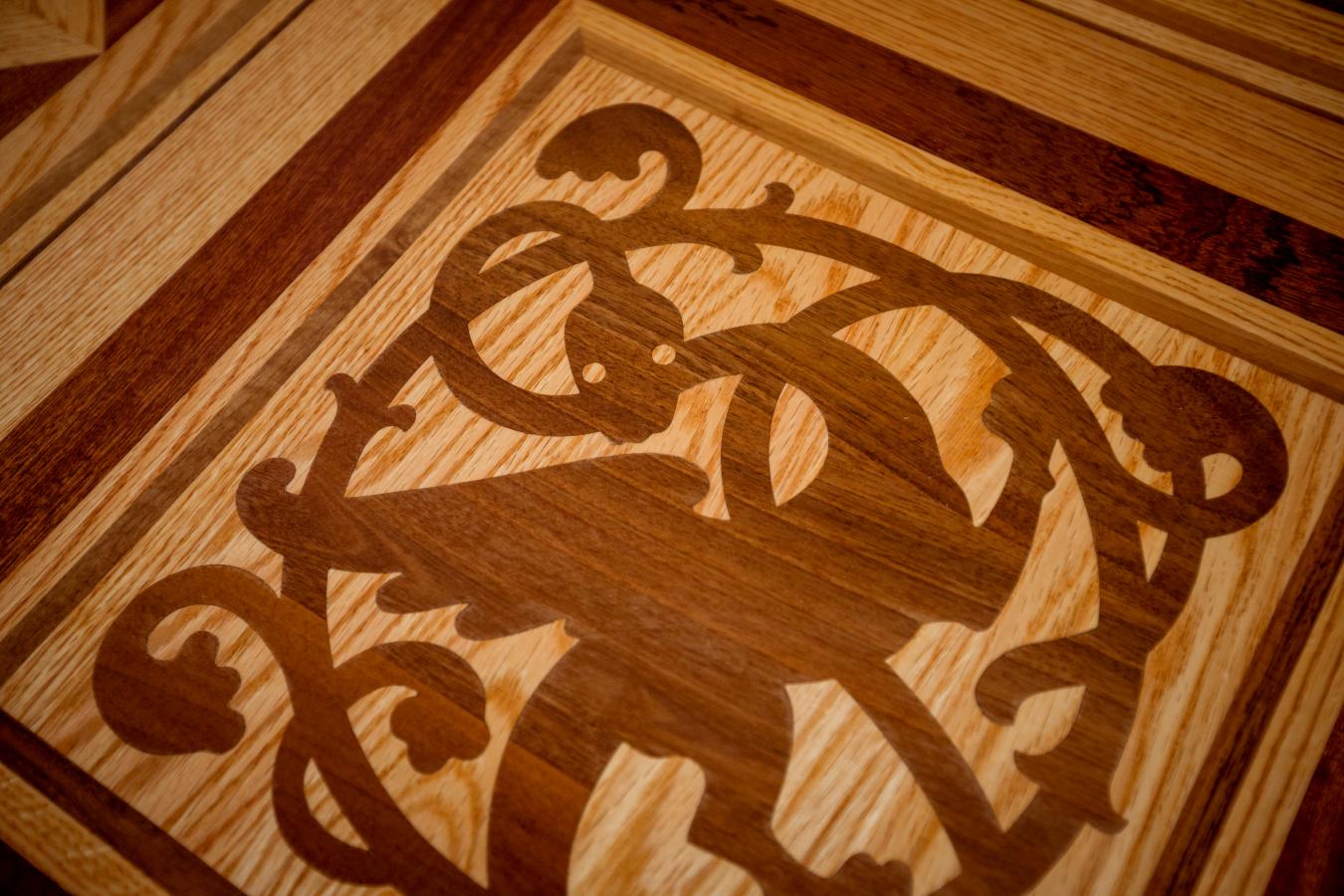
The marvel of the palace
The assemblage of masterpieces was much appreciated by the monarch, Franz Joseph, who ordered that the interior be displayed at the 1900 Paris World’s Fair. The installation in the French capital city gained enormous public and critical acclaim, and won several prizes, including the Grand Prix. The public was also permitted to view the ornate hall in the Palace of Buda Castle when it was completed in 1902.
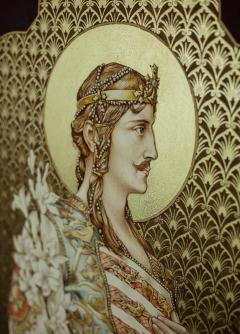
Wartime destruction
The buildings of the palace suffered extensive damaging from the bombing and the several-week-long fire in the Second World War. St Stephen’s Hall was completely burned out, and all its furnishings destroyed. It was not restored after the war, and was mostly used as a store.
The rebirth
Under the National Hauszmann Program, St Stephen’s Hall is being authentically recreated. Its internal layout, materials, decoration and furnishings all follow Hauszmann’s original plans. Design has been assisted by surviving plans, sketches and photographs, and the fittings and furniture are being made in about twenty workshops throughout the country by craftspeople who are using original materials to produce the ornate furnishings with the highest level of accuracy.
The work of today’s artists and craftspeople are worthy of the words by which Hauszmann, one hundred years ago, characterised the products of his associates:
I must pay tribute to the fine artists and artisans who took part in producing this work, which in its material and the quality of execution will I believe be widely recognised abroad.
After 20 August 2021, visitors to the recreated St Stephen’s Hall may appreciate for themselves the marvellous work of these artists.
Since its opening, St Stephen’s Hall has won the admiration of scores of public figures, including Nobel Prize-winning physicist Ferenc Krausz, Áron Szilágyi, three-time Olympic champion in fencing, Marco Rossi, manager of Hungary national football team, and singer Vera Tóth.
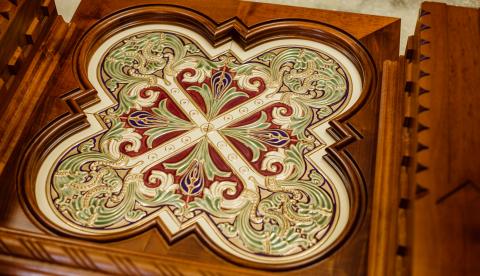
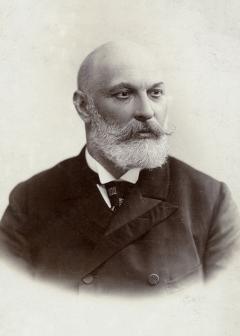
Alajos Hauszmann was renowned as an architect of grand public buildings during the period of the Dualist Monarchy, and he also designed many private houses and villas in Budapest. Among his best-known works are the New York Palace, the Royal Law Courts (the former Ministry of Justice building on Kossuth Square) and the main building of the Royal Joseph University (now Budapest University of Technology and Economics). The climax of his career was the design and direction of the Royal Palace of Buda Castle, where he created one of the most outstanding complexes of royal buildings in Europe. Alongside his architectural work, he taught for more than forty years in the Royal Joseph University, thereby exerting a considerable influence on the next generation of Hungarian architects. He received many awards and honours for his work, including the Grand Prix at the 1900 Paris World’s Fair.
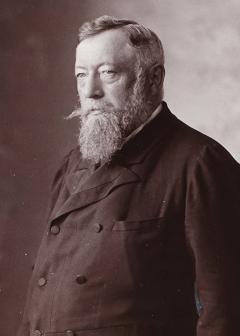
Apprenticed to a joiner at the age of thirteen, Endre Thék went on to learn his trade in Vienna, Munich and Paris. When he was refused employment by the Üllői Road furniture factory after his return to Budapest, he opened his own workshop. This soon earned him a good reputation and business success, and he eventually bought over the furniture factory that had turned him away. Thék’s factory produced joinery of the highest quality, and he received many orders from the royal court. He was chosen to make the wood panelling for St Stephen’s Hall in the Palace of Buda Castle. During the Hungarian Soviet Republic, his furniture factory was seized and he fled to the countryside, fearing for his life. The loss of his business affected him deeply, and he died shortly afterwards.
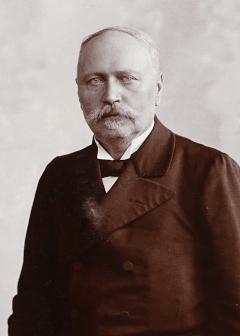
Gyula Jungfer grew up in a family of blacksmiths, starting with his grandfather. He opened his own workshop in the Józsefváros district of Budapest in 1872, and a major exhibition in Paris in 1879 spread his reputation abroad. His wrought-iron grilles and wall brackets made a strong impression on the Parisian public and the industry. His company developed further, and had showrooms in London, Paris and New York. Among his regular customers were the Serbian royal couple and the Prince of Wales. Jungfer did the blacksmithing work for the Hungarian Parliament building, and Hauszmann wanted nobody else for the manufacture of the wrought iron gates, candelabra and other wrought iron work for the Palace of Buda Castle. Jungfer also executed Hauszmann’s plans for the Habsburg Gate and its ornate fence, and he was also responsible for the bronze ornament of St Stephen’s Hall.
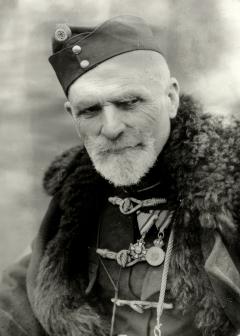
Born in 1856, Alajos Strobl started work as a young apprentice in the Chemnitz stove factory, but he soon showed his abilities as a sculptor. After completing his studies in Vienna, he began to receive many orders from Budapest and by the age of thirty, he was renowned throughout the country. Among his works are the statue of János Arany outside the National Museum and the statue of Saint Stephen on Fishermen’s Bastion. He was commissioned by Franz Joseph to make the splendid group of statues for the Matthias Fountain in Buda Castle. Strobl made the bust of the first king of Hungary for St Stephen’s Hall.
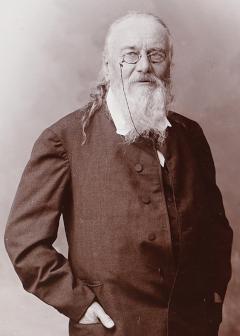
Vilmos Zsolnay of Pécs initially trained as a painter, but his father intended him for a career in commerce and sent him on a study tour that took him to Vienna and Munich. Upon his return, he opened a bazaar where he sold goods ranging from porcelain to weapons. At that time, he was mostly interested in wine making; the Zsolnay pottery works was run by his father. After taking over the direction of the factory in the 1860s, he devoted his entire energy to developing new ceramics. This resulted in “porcelain faience”, frost-resistant “pyrogranite” and the “eosin” technique. In a short time, Zsolnay wares were admired throughout Hungary and abroad. Among the company’s many customers was the Palace of Buda Castle. The magnificent fireplace of St Stephen’s Hall was made in Vilmos Zsolnay’s workshop, as were the pyrogranite portraits of Árpád-dynasty kings and saints. He loved the arts, and made many charitable donations. He was also president of the Pécs Cycling Society. In 1898, two years before his death, he was made an honorary citizen of Pécs.
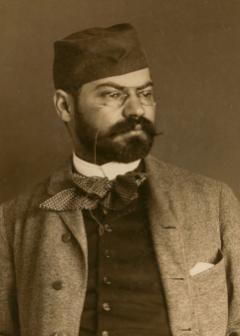
Ignác Roskovics was born into a deeply religious family in Upper Hungary (now Slovakia). In his youth, he was fascinated by painting and painted pictures on biblical themes. In 1884, this Hungarian painter came to the attention of Franz Joseph, who purchased his painting Little Red Apple of 1885 had a successful career in prints for several decades. Alajos Hauszmann commissioned Roskovics to make full-figure portraits of the great Hungarian kings, images made into majolica tiles for St Stephen’s Hall in the workshop of Vilmos Zsolnay. His statue now stands on the Dunakorzó esplanade beside the Danube.
![Haas_II_Fülöp_[Báró_Teicheni_Haas_Fülöp]_h_00363231_150dpi_1280px_ONB](/sites/default/files/styles/creator_item/public/2021-08/Haas_II_F%C3%BCl%C3%B6p_%5BB%C3%A1r%C3%B3_Teicheni_Haas_F%C3%BCl%C3%B6p%5D_h_00363231_150dpi_1280px_ONB.jpg?itok=zCLGgS07)
One of the most prestigious trade names of turn-of-the-century Budapest was that of the carpet and textile makers Fülöp Haas and Sons. The company’s building in Gizella Square (now Vörösmarty Square) was admired by everyone in the city. The business was built up by Fülöp Haas the Elder, who first sat at his loom at the age of sixteen, and had a factory of sixty looms when he was still a young man. The company’s reputation spread far beyond Budapest – to Vienna, Venice, Milan, Paris and London. By 1880, he and his two sons had all died. His grandson, Fülöp Haas the Younger, floated the business as a public company and renounced management of the factory. The company received many orders from the imperial court, and supplied carpets for a new royal train and the gold brocade for the wall hangings of St Stephen’s Hall in the Palace of Buda Castle. By then, the company was controlled by shareholders, a family business only in name. The world-famous brand was swept away by the Second World War.
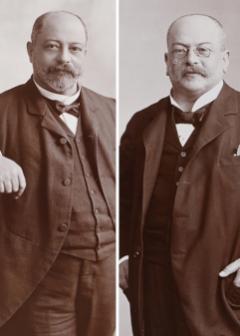
The Neuschlosz brothers Ödön and Marcel were sons of a family that had been involved with timber and woodwork for centuries. The highly reputed company Neuschloss and Son, founded by their uncle, Károly Neuschloss, made the roof truss for the Opera House and the ornamental ceiling of the Royal Riding Hall in Buda Castle. Ödön and Marcel were also involved in the turn-of-the-century development of Buda Castle, and they supplied the parquet for the legendary St Stephen’s Hall. Among the many other famous Budapest buildings they worked on were Vajdahunyad Castle in Városliget park, the Parliament building, and the Royal Law Courts. They also built cadet schools in Pécs, Sopron and Nagyvárad (now Oradea, Romania) and barracks in Przemyśl, Lemberg, Vác and Nagyvárad; and they rebuilt the town of Eperjes (now Prešov, Slovakia) after it was destroyed by fire.
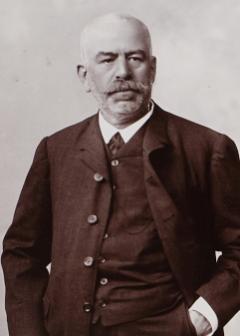
The Imperial and Royal court upholsterers Gelb Mór & Sons were recognised by Hauszmann as a professional authority. The professionals of the period were not only connected by their careers and achievements, but also friendship. There was nothing extraordinary about Endre Thék himself being the godfather to a member of the Gelb family. When constructing St. Stephen’s Hall, Gelb Mór & Sons was ordered to supply the curtains and the upholstery fabric, upholster the furniture and hang the Haas tapestry. The French partners of the company were also considered during the selection process; they provided the missing materials and the skilled experts needed to do the gold embroidery.

